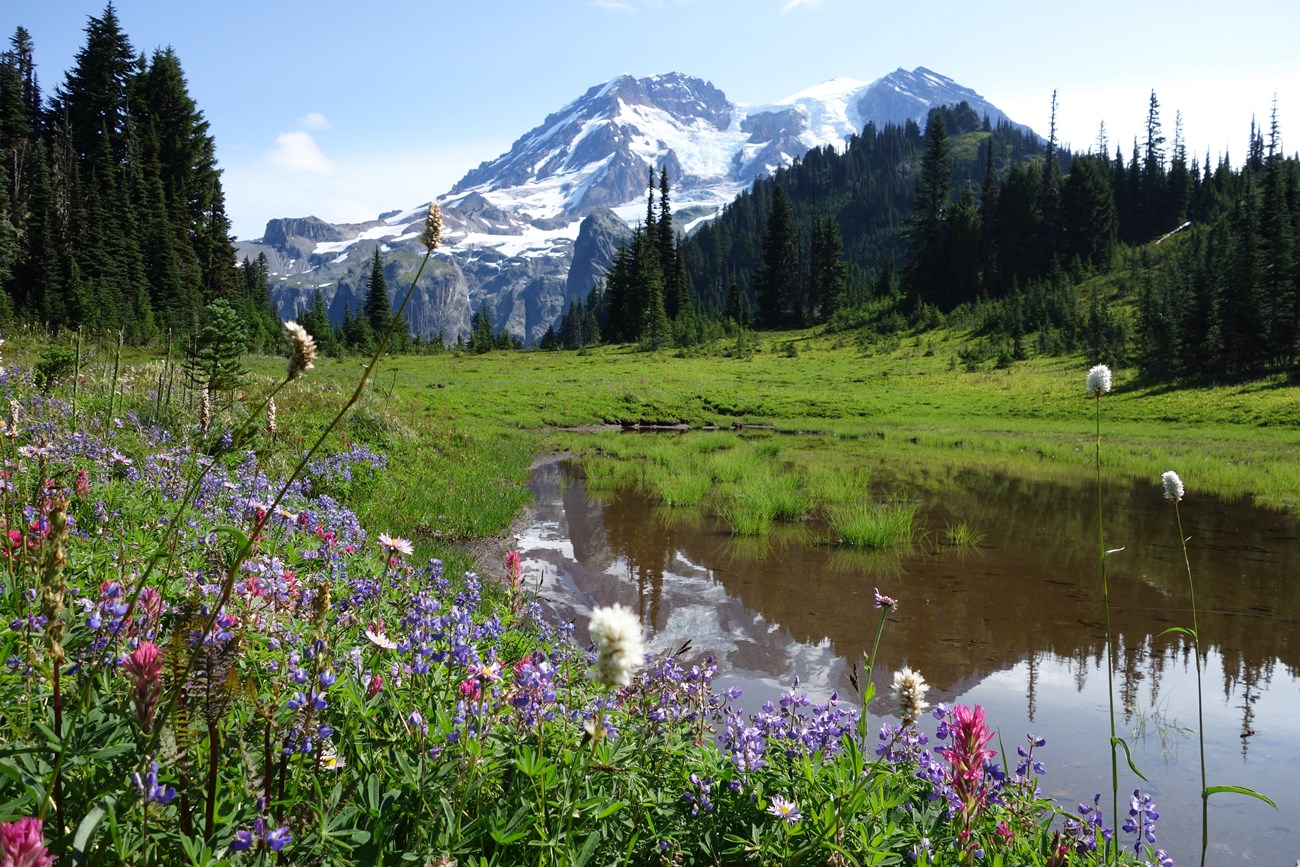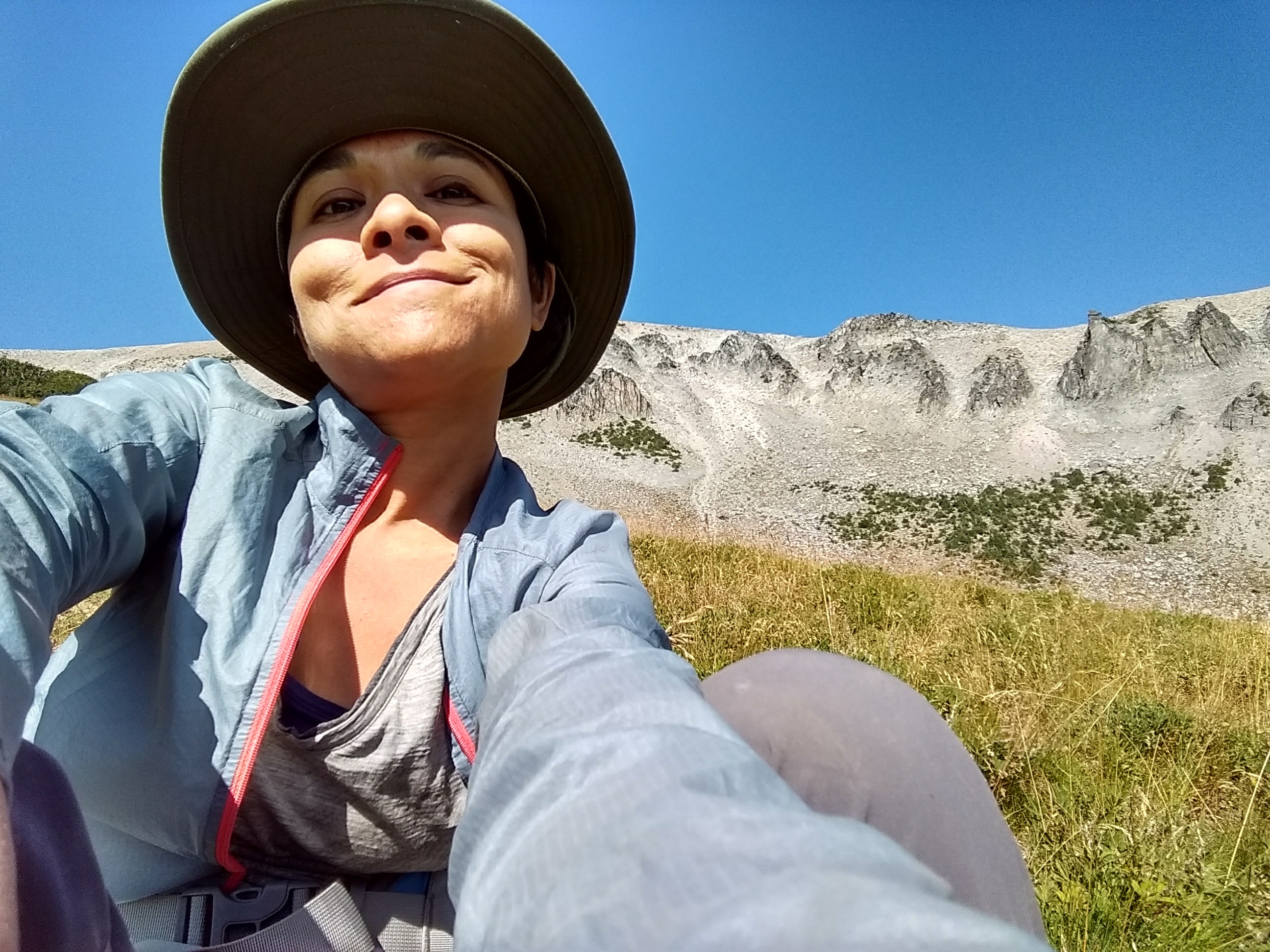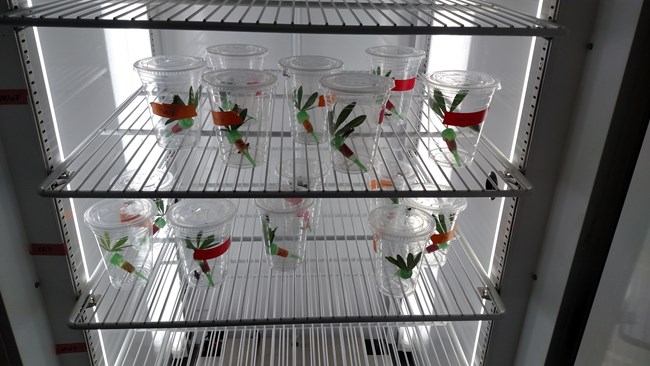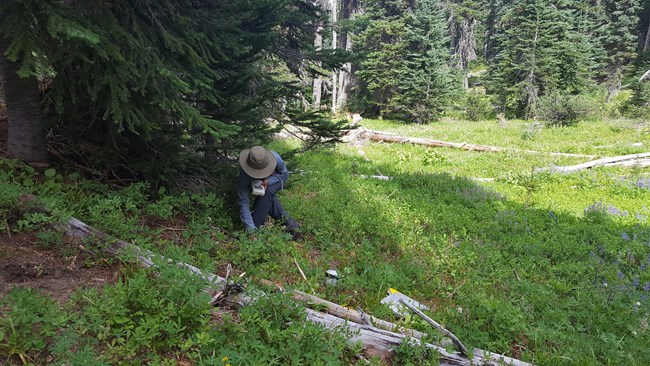Last updated: August 26, 2022
Article
Questioning Mountain Lupines, Grasshoppers, and the Community of Scientists

“Have these leaves been chewed more than those leaves? How can I lower barriers for people who want to get into science? And wait – you guys, was that a bear?!”
Questions about leaves and social justice and bears were just a few that worked their way into Dr. Meera Lee Sethi’s head recently while conducting research on plants and insects in Mount Rainier National Park in Washington. Together, they reveal science as an adventurous path to understanding and caring about our shared world – one that should be accessible for everyone.
You’d be hard-pressed to find a more beautiful place to study plants and insects than the meadows of Mount Rainier, also known as Tahoma in local Indigenous languages. Purple-flowered lupines backed by white snowfields and dark-green firs inspire countless photographs. Lupine leaves are eaten by grasshoppers that clatter and leap as you pass by on the trail.
This was the perfect place for Dr. Sethi to do her research while a graduate student at the nearby University of Washington. She’s interested in the interactions between plants and insects – especially the herbivorous ones that eat leaves. Given the global abundance and diversity of plants and insects, their important roles in ecosystems, and the fact that they’re sensitive to climate change, studying their interactions is pretty important.

But Dr. Sethi cares about more than just the science of how climate change is affecting lupines and grasshoppers. She knows that science is relevant to people, too. It can seed a love of nature, satisfy a curiosity about the world, and empower communities to overcome their restraints. She sees that many people who want to become scientists confront hurdles not of their own making. So her thoughts in the meadow, along with her memories of childhood in Singapore, spur additional interests and work in science outreach and environmental justice – especially with communities that have historically been separated from science.
Since national parks are public places where people can engage in science, I was eager to talk with Dr. Sethi about both her research and how she views science in the context of our diverse society.
What's the basic question you're interested in and why?
How insect herbivory will respond to climate change is interesting. Temperature has a profound effect on insect bodily processes like reproduction and feeding and growth. We expect there will be more insect herbivory as climate warms. It’s clear from laboratory experiments that if you increase temperature you see higher herbivory. But it’s important to study this in nature, too. So people use elevational gradients on mountains as a proxy for what might happen in the future.
Lower elevations are warmer and so they might be what higher elevations will look like in the future as climate continues to change?
Yeah, exactly. People compare different elevations to see what the future might be like. There have been very mixed results. In some systems there's higher herbivory at low elevations. In some systems you see no relationship. And in other systems you see the opposite – higher herbivory at high elevations. So that is an open question still: What happens with insect herbivores on mountains?

How did you answer that question?
I was trying to measure herbivory on an elevation gradient and simultaneously measure as many other things as I could. I’d be able to say this is the pattern, and these are the things that are driving it. And therefore, what might happen in the future.
I chose five elevations with lupines. My assistants and I would crouch down and visually estimate tissue loss on sampled leaves and then do a simple calculation to estimate for a whole plant how much has been lost to herbivory. They’re mostly being eaten by grasshoppers. And grasshoppers have a distinctive chewing pattern so you can be sure that’s what you’re counting.
We measured the carbon:nitrogen ratio in leaf samples. That tells you how nutritionally valuable the leaf is. And we measured leaf mass per area, which basically means how thick is the leaf. That could affect how easy it is for grasshoppers to chew.
We collected data on when snow melts at each plot. These grasshoppers have annual life cycles. They emerge as little juveniles from eggs in the soil at the beginning of the season and they have to develop into adulthood and mate before the snow falls again. The snow free period is basically their entire life outside the egg.
And I did some experiments. I collected grasshoppers and leaves from my highest and lowest elevations and placed them in different combinations in temperature-controlled boxes in the lab. I was trying to figure out the relationship between temperature, where on the mountain grasshoppers live, where on the mountain lupines live, and how fast these grasshoppers feed.
Have you found some answers to your questions?
Yes, and they’re still going through peer review by other scientists. Basically, I found the opposite pattern than you might expect if all other things were equal and the only factor that matters is air temperature falling as you go up a mountain. The high elevation lupines were eaten more than the low elevation lupines. There are a number of different reasons for that. Nutritional quality of the leaves, faster feeding by high- versus low-elevation grasshoppers, the history of snow conditions at different elevations, the basking behavior of grasshoppers – my results suggest all these things play a role. The upshot is right now on Tahoma, high elevation lupines are being hit relatively hard by grasshopper herbivory and no, they're not going to look like low elevation lupines as the climate warms.
Being in mountain meadows all day sounds idyllic. How does the environmental esthetic compare to the intellectual motivation of the questions that you’re asking?
It's more than the esthetic. It's being curious about interactions that I see all the time while hiking up in the mountains. I was very lucky to fall into a lab where that was an option. But I do think that if I ended up in a coffee plantation and there was a cool beetle-plant interaction or something, that would be just as interesting.
The field is idyllic on some days. But on some days, it's freezing and there's hail. And on Tahoma there are these snow-melt mosquitoes. I said no one on the field team can wear insect repellent because it's going to get on the leaves. Who knows what effect that might have on this interaction that we're trying to observe? So everyone was insect repellent free, and the mosquitoes are just awful.
Do you have a favorite story about life in the field?
We once heard this strange noise. I don't really know how to describe it. We knew it was an animal but none of us had heard that sound before, and it was close. As we were walking out of our field site, we passed a tree that had bear claw marks. They'll pull bark off into strips so they can eat the soft tissue. The tree clearly had just been used by a bear for that. Later we looked up the sound online because we thought “oh my god that was a baby bear.” I don't know, but hopefully we weren't in between a mama and her cub.
How do you describe your path to science?
I did not fall in love with science, or even really the natural world, until I was an adult. In Singapore, my humanities classes didn't always start with people telling you what the right answers are. But I felt like my science classes did. And so I had this chip on my shoulder about science being a place where people just told you what was right. And that is not what science is. But I didn't get that, until I was much older.
In college I took a couple of science classes and thought “This is actually very cool. But it's too late. I can't switch my path now. I'm a literature person.” So science was just a thing I enjoyed outside of my central path. I ended up doing a Master's in children's literature and teaching because I loved the humanities and I wanted to share that with kids. I taught for a very brief time, then worked as a textbook editor. Still, I was super interested and reading about science in popular books. At some point, I decided to try writing about science, because I was like “OK at least I know how to write. Maybe it can be part of my career that way.”
Well, no matter what the topic was, as I was interviewing scientists, I started to feel the envy. I was like “I have to write the story, and then I have to set this topic aside, and I don't get to understand it at a deeper level.” But all these researchers I'm interviewing get to pick one thing and then spend lots of time going deep and understanding it. And I was jealous of that and I wanted to figure out a way to get that.
You eventually realized science is not people telling you what’s right. For you, what is science?
There’s this saying, “Science is what scientists do.” So it's colored with the biases that all of human society has. But to me, science is a way of understanding the world that is based on evidence and observation. It’s about expanding knowledge, and pushing at the edges of knowledge, and not really about anything being permanently defined or set in stone.

Science is a way of knowing. I also think of science as a way of being and even as a way of caring about the world, or of giving back.
One of the things that drew me to science is that it gave me some good reasons not to think about myself, but to think about the world beyond my life. I feel less self-centered when I'm practicing science. A way of caring? I think that depends on the field that you're in. Most ecologists are in the game because of a love of the living world, which includes humans. If you're an ecologist doing science today, you can't do that without thinking about how vulnerable whatever you're studying is to change and loss. I'm trying to think if this is true of all science. I don't know.
What has led you to public outreach and engagement, and are there particular communities you hope to engage?
What has led me is the fact that I didn't love science as a young person. I'm curious about how that happens for people and I want to help facilitate connections to science because of how much it has brought to my life.
I'm interested in reaching any communities where there's suspicion towards science and scientists. And I'm really interested in reaching people who have been historically excluded from the practice of science. In that case I don’t need to encourage people to love science. I want to do work that helps people get into the field of science. I don't think there's a lack of interest in communities of color, for example, about science. There can be lots of barriers to entry, though.
You’ve written about making science and conservation more just and equitable spaces. How do you think about the needs and opportunities to do so?
We know that communities historically excluded from science are already doing science in many ways and are also organizing, particularly around climate change. I think the challenge and the opportunity is to support and fund grassroots or community-based organizations that are doing climate justice work or environmental stewardship and management. And trying to reach a point where White-led conservation organizations are not gate-keeping.
What is the role of scientists in making science more equitable and inclusive?
I think it depends on who you are as a scientist, and what kinds of things you already do. Some ecologists and conservation biologists are working in spaces where there are local communities that aren't involved in the science. If you're somebody like that, then I think you have a responsibility to understand enough so that you can approach that community and ask, “What is it that you actually want? And is there any way in which my work can facilitate that?”
I also think that the way we recruit and select graduate students to enter science is flawed. There are efforts to make that process more equitable and to increase diversity in graduate student communities. But ultimately, it's individual senior scientists making decisions, which may or may not be conscious, that affect who even knows they're recruiting, and who may apply in the first place.
What else do you want people to know?
How amazing and wonderful insects are. I had done bird projects and I still love birds. I mean, who doesn’t love birds? But as I was doing the field work, there's a lot of sitting and waiting. If you're sitting and waiting, on the ground you're going to see invertebrates. The fact that there's just so much life right there is the reason I ended up studying insects. It's not something I set out to do. I just kept noticing them and being interested in their behaviors, and their interactions with plants.
I guess what I want people to know is how important they are. Besides plants, they’re the most fundamental link in the chain that connects everything.
Tim Watkins is the Science Access and Engagement Coordinator for the National Park Service, based in Washington, DC. He taught college biology and did field and laboratory research on tadpoles for many years and has a passion for helping people see science as an accessible human endeavor full of interesting stories.
